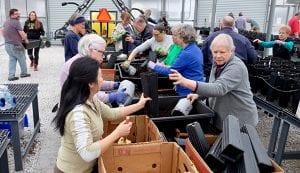
Volunteers form an assembly line to accomplish the planting more efficiently.
On February 1, 40 MD-TACF Chapter members and volunteers planted about 2,000 5th-generation hybrid chestnuts in the greenhouse located at the Baltimore County Center for Maryland Agriculture and Farm Park. This was the second year of chestnut plantings in preparation for small stem assays at this greenhouse.
From lessons learned last year we have made, and plan to make, the following changes and improvements this year:
- More volunteers recruited and number of seeds to plant were reduced. (We found that a seed to volunteer ratio of 50:1 works well.)
- More spacing for pots; instead of completely filling the racks we loaded them in a checkerboard pattern with an open row between each double row. Note: The racks were made from wire fencing that had spacings matching the pot size.
- Using tables for potting the soil to eliminate back strain.
- Measured scoops were used to fill the pots.
- An electric mortar mixer was used to prepare the soil.
- Pot placement was randomized to avoid location-dependent effects on growth.
- Planting began eight days earlier allowing us to move the trees outside earlier.
- Pots were placed in the center of the greenhouse for more uniform temperature. We plan to water less often to reduce mildew problems, starting at once per week and increasing the frequency if needed.
- Planning to use liquid fertilizer instead solid pellets.
- Planning to improve the inoculation procedure to reduce “no takes.”

MD-TACF members David Sann and Jim Curtis prepare the racks for the plantings.
The procedural changes allowed us to complete the planting in about half the time used last year. Further, we expect more rapid growth and fewer loses as a result of the spacing, watering, and fertilizer changes.
The chestnuts planted this day came largely from our breeding orchards, where the trees had been selected for chestnut blight resistance and American characteristics. Most of these chestnuts are only 1/16th to 1/32 Chinese and the remainder American. In May we will move the trees outside, and we will use small stem assays to select these trees again for blight resistance. In this process the small seedlings are scored and exposed to the blight fungus, Cryphonectria parasitica. Only those seedlings showing satisfactory blight resistance will be transplanted to our seed orchards. In our seed orchards these trees will again be selected for blight resistance and American chestnut characteristics. Then, in a few years these selected trees will produce our sixth and final generation of chestnuts, which will hopefully show good blight resistance.
This process of small stem assays allows us to eliminate inferior trees earlier and reduce the number of trees planted in our seed orchard. Planting in a greenhouse also gives better control of the germination.
For more details about small stem assays, read the article by TACF Regional Science Coordinator Tom Saielli and MD-TACF Chapter member Bruce Levine, in the winter 2019 issue of Chestnut magazine (page 24).
